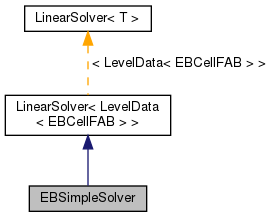#include <EBSimpleSolver.H>
◆ EBSimpleSolver()
| EBSimpleSolver::EBSimpleSolver |
( |
| ) |
|
◆ ~EBSimpleSolver()
| virtual EBSimpleSolver::~EBSimpleSolver |
( |
| ) |
|
|
virtual |
◆ setHomogeneous()
| virtual void EBSimpleSolver::setHomogeneous |
( |
bool |
a_homogeneous | ) |
|
|
virtual |
◆ define()
Define the operator and whether it is a homogeneous solver or not. The LinearSolver does not take over ownership of this a_operator object. It does not call delete on it when the LinearSolver is deleted. It is meant to be like a late-binding reference. If you created a_operator with new, you should call delete on it after LinearSolver is deleted if you want to avoid memory leaks.
Implements LinearSolver< LevelData< EBCellFAB > >.
◆ setNumSmooths()
| virtual void EBSimpleSolver::setNumSmooths |
( |
const int & |
a_numSmooths | ) |
|
|
virtual |
◆ solve()
◆ m_isDefined
| bool EBSimpleSolver::m_isDefined |
|
private |
◆ m_operator
◆ m_homogeneous
| bool EBSimpleSolver::m_homogeneous |
|
private |
◆ m_numSmooths
| int EBSimpleSolver::m_numSmooths |
|
private |
The documentation for this class was generated from the following file:

 Public Member Functions inherited from LinearSolver< LevelData< EBCellFAB > >
Public Member Functions inherited from LinearSolver< LevelData< EBCellFAB > > 1.8.13
1.8.13